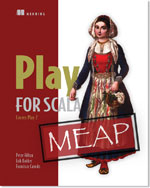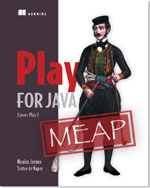Play framework 2 books

For the last six months we’ve been working on a not-so-secret project to write books about Play 2. Ideally, one book about the Play framework would have been enough, but these days there isn’t just Java: now there’s Scala as well, which is why we are happy to announce both Play for Scala and Play for Java.


MEAP release
Both books are one-third complete, and now available for purchase on-line via the Manning Early Access Program (MEAP):
-
Play for Scala by Peter Hilton, Erik Bakker and Francisco Canedo
-
Play for Java by Nicolas Leroux and Sietse de Kaper
The early access edition gives you four chapters, plus new chapters as they are written, the opportunity to discuss the books with the authors on Manning’s Author Online forum, and the final book when it is published.
Free chapters
The first chapter of each book is currently available on-line for free:
-
Play for Scala chapter 1 - Introduction to Play 2
-
Play for Java chapter 1 - Getting started
Play for Scala
Play for Scala defines Play as the easiest and default way to build web applications with Scala. The book gets you started with Play and then focuses on how to apply standard web application development techniques, which will be familiar to developers who have built web applications with another platform, using Play and Scala. The third part of the book will cover more advanced topics. The content and code examples are Scala only and assume basic Scala knowledge, rather than reproducing or reinventing existing high-quality tutorials such as Scala School. Scala beginners won’t have any problems keeping up.
Readers need this book because despite the rising popularity of Scala as a post-Java language that runs on the Java Virtual Machine (JVM), none of the existing web frameworks have captured the attention of mainstream web developers. Play has achieved this for Java web developers in the two years since Play 1.0’s October 2009 release, and added Scala support with Play 1.1’s November 2010 release. Scala support is fully-integrated in Play 2.0, putting it on equal footing with Java, making Play a true Scala web application development framework.
Play for Java
Play for Java is the book for people who want to start developing web applications using the Play and Java, whether they are new to Java web development or have a Java EE background. The book assumes basic knowledge of the Java language. This book explains that web development does not need to be complex: simplicity is at the core of Play. The book will explain all aspects of the Play framework, and can serve as a complete tutorial as well as a reference. It will also address Java EE developer concerns, demonstrate how a stateless web application can fit in an enterprise environment, and show the productivity bonuses one can get from using Play.
The book’s running example introduces the reader to the philosophy behind Play, and how to apply it in practice. Some of the patterns and concepts found in a Play application will be contrasted with examples found in Java EE applications, to ease the reader’s mind shift to a stateless way of thinking about web applications. Throughout the book, discussion of Scala code will be kept to a minimum, since you don’t have to learn Scala to use Play.
Who publishes books these days anyway?
Technical book publishing isn’t dead just yet, but a few things have changed in the last ten years. There are now more ways to share information, this hasn’t killed off any of the media completely, any more than video made cinema redundant, or ‘moving pictures’ stopped everyone listening to the radio. What we do have is more choices.
The important thing about different media is that you present information differently, instead of just translating content directly to another format. We have already learned a lot from the team at Manning about what we can do in a book and how it’s different to blog posts and on-line documentation.
Nobody only publishes books these days, and we’re not just writing books about Play. We also publish code, present at conferences, host informal developer events, and post on-line. This worked pretty well for Play 1.x, which went from first release to mainstream web framework in two years. Things are moving faster with Play 2, and we decided to write books to help accelerate adoption.
We have several goals for the books, which are all part of helping smart software developers to get things done:
-
share our Play expertise - we don’t have time to build all of the web applications the world needs
-
bring Play to a wider audience - some programmers just prefer books, and they need Play too
-
keep the books less than 2 cm thick - we don’t like books with gratuitous padding and a lack of focus
-
avoid writing books for idiots - these are books for smart but busy programmers.
